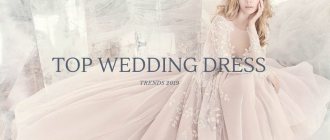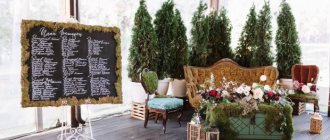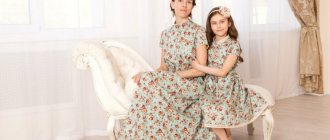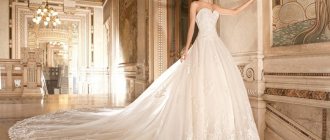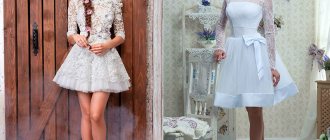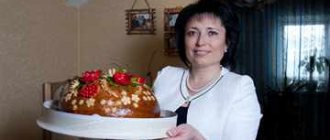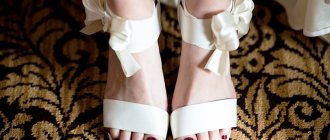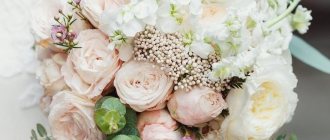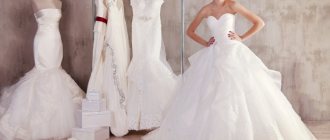In Ancient Rome, the bride's attire was very modest
To hide the girl’s beauty, she had to wrap herself in ordinary woolen blankets, but the groom was given a white outfit. During the Renaissance, wedding dresses in bright colors (red, bright yellow, orange) became popular. Wedding suits were decorated with lace and rich gold-colored embroidery. However, there were also more modest outfits in black, embroidered with silver thread.
In the 17th and 18th centuries, openwork lace, which was used to decorate skirts with numerous frills and bodices, became a mandatory attribute for decorating a wedding dress. Lush dresses with Medici collars and luxurious embroidery, lace trim or expensive fur were fashionable. The groom's wedding dress was decorated with a collar and cuffs made of lace. Different tones could be used (from delicate pastels to bright ones). The most popular colors were soft pink, light blue and green.
Girls from ordinary families walked down the aisle in gray dresses. Brown and beige outfits have become fashionable for going to church on Sundays.
History of wedding dress styles
My best friend is getting married. And of course, the issue of choosing a wedding dress is very important for her. And I decided to study a little the history of the wedding dress, in order to make it easier for us to choose a dress, and maybe come up with something new. And everything new is well forgotten old. As they say, read the story, everything is written there. Here we read:
The history of the wedding dress is fascinating and very interesting. We invite you to read some especially interesting facts from the history of the wedding dress.
Peasant girls of the 17th-19th centuries prepared their dowry for the wedding, and a wedding dress, as soon as they acquired the necessary sewing skills, they also made the fabric themselves. In Rus' there was a tradition of passing a wedding dress from mother to daughter, because a woman could wear it only once in her life
The traditional Russian bride's dress was red , as it symbolized the beauty and fertility of a woman. White wedding dresses appeared only in the 17th and 18th centuries in Europe. In Russia, a woman in a white robe was considered the “bride of Christ,” that is, she had to leave worldly life and go to a monastery.
At the end of the 18th and beginning of the 19th centuries , figure-hugging and thin flowing fabrics were in fashion, with a deep neckline emphasizing the advantages and short sleeves that open the shoulders. The main fabric is white satin, and on top of it is a flowing transparent fabric. White elbow-length gloves become a must-have accessory for the bride. The image of the bride embodies romanticism and lightness.
By the mid-19th century, crinoline and dresses decorated with bows, lace, and frills came back into fashion. With the help of a bustle (special pad) it is very fashionable to increase the back of the dress.
At the end of the 19th century, everything changed: bows and crinolines receded into the background. Comfortable, elegant, high-neck and slightly flared dresses are in favor.
In the 20th century, the wedding dress underwent many changes. The length and style of the dress changed a lot.
In the 20s , this is a bride in a modest dress with a low waist and a hat.
In the 30s, more feminine, elegant styles again prevail.
In the 40s - clear, straight lines, rigor, simplicity.
In the 50s, romance and lightness came into fashion. Fitted dresses with a full midi skirt.
In the 60s there was a revolution in wedding dresses. “Mini” is becoming trendy. And the wedding dress becomes short without unnecessary decorations and details.
In the 70s, the hippie style with folklore motifs and knitted elements contributed to the details of the wedding dress.
In the 80-90s, “retro” first came into fashion, and then it was replaced by a comfortable sports style of clothing - a symbol of an active lifestyle and a sporty lifestyle.
Nowadays, wedding fashion synthesizes all styles. The choice of color, cut, and style of a wedding dress depends on taste, preferences, and the theme of the wedding.
If you study a little the history of the wedding dress, you can wear an outfit from any era and still look modern, stylish and unique.
By the end of the 18th century, the Rococo style became fashionable
Newlyweds appreciated wedding dresses with a silver tint. The lush bottom was decorated with frills and ribbons, and also, for splendor, frames made of rods (willow, steel or plates made of whalebone) were used. To make the bride's waist look as thin as possible and her chest to become fuller, tight corsets were used. The bride's status was emphasized by a long train and sleeves.
In addition, at this time, the empire style became fashionable - straight-cut dresses with a high waist, which emphasized the sophistication and charm of the newlywed.
In the 19th century, wedding fashion changed very rapidly.
White color for wedding dresses came into fashion during the time of Queen Victoria of England. She was the first to shine at the wedding in a snow-white dress and veil, embroidered with luxurious golden lace. Subsequently, this style became known as “Victorian”. In those days, wedding dresses were simple and strict styles, no deep neckline, open shoulders or back. Even the newlywed's hands had to be covered with long sleeves and dressed in lace gloves. The bride's head was decorated with a long lace veil complete with an orange blossom wreath, symbolizing the girl's innocence and chastity. By the end of the century, wedding fashion had undergone some changes, as a result of which the skirts of wedding dresses became flowing and light, and the brides themselves resembled elegant porcelain figurines.
Wedding dress 1910
emphasized the sophistication and elegance of its owner. As a rule, these were loose-fitting dresses with lace sleeves, complemented by a veil and long gloves. Newlyweds of this time preferred closed outfits and a minimum of cosmetics. In 1920, shorter wedding dresses became fashionable than ten years later. Arm-baring and V-neck styles were especially popular.
Most often, brides used pearl threads as decoration. Wedding fashion corresponded to the clothing style characteristic of that time. Most brides preferred a white dress with a straight cut, low waist and high neckline. A veil of openwork lace completed the look. Brides of the 1930s favored glamorous A-line and fishnet styles made from shiny faux fabrics.
Brides of the gloomy 1940s, most often, were dressed in ordinary beautiful outfits, which they sewed themselves for the wedding. In 1945, dresses with long sleeves and gathered, voluminous shoulders became especially popular. The style is quite simple, but effective, emphasizing the thin waist. Pearls were most often used as decoration. The look was completed with light makeup on the upper part of the face and bright lipstick.
Dresses for brides in an ancient style - models from the Middle Ages
The girls' appeal to historical forms of dresses is based on their idea of an ideal wedding of the past, a picture of a magnificent celebration in the bosom of unique architecture, nature and the unique setting of that time.
The more harmonious and brighter this celebration seems to them, the more concretely the image of the bride emerges. The choice of ceremony location also plays a role. Some people prefer outdoor celebrations using themed surroundings; some are not averse to getting married under the arches of real ancient castles or in a palace. Today the choice is almost limitless.
When choosing one or another historical style, knowledge of its characteristics remains definitely important. This will not only allow you to reliably sew a wedding dress to order, but also take into account the historical aspects of organizing a thematic celebration, especially for relatively distant centuries.
Wedding dresses of the 14th–15th centuries are distinguished by their special privacy. It is due to a religious moment: at that time it was considered obscene to expose the body, and fashion followed this precept. Dresses were also supposed to show that the girl belonged to a certain class or even clan. Hence the combination of specific colors taken from coats of arms and family flags.
Moreover, this concerned not only rich nobles and royalty. In the Middle Ages, in large trading and craft cities there was a color classification of streets; ordinary people during weddings turned to them whenever possible.
The dresses of the nobility had the following features:
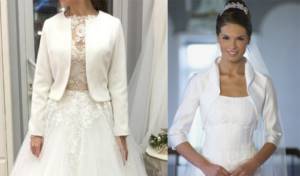
- mandatory floor length, with a possible small train;
- long sleeves flared from the elbows, sometimes reaching the knee line;
- waist narrowed by a corset;
- the presence of a cape that completely covers the bride’s head;
- expensive, heavy fabrics;
- precious stones and embroidery as decorative elements (can cover the entire dress);
- obligatory use of genus flowers.
The dresses of medieval brides had a slightly lowered collar, and the girl’s neck was often decorated with precious necklaces or scatterings of beads.
The choice of stones not only depended on the color of the dress, but was also a symbol of the family line through the female line.
Dress of burghers and middle class:
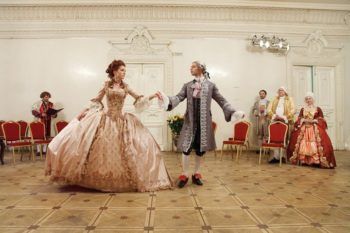
- fluffy multi-layer straight cut dress, maxi length;
- slightly tapered sleeve;
- closed top, collar possible;
- a mandatory headband with folded edges; in England, a cap;
- a small veil or train can extend both from the collar and from the headdress;
- fur and embroidery as decoration.
The wedding ceremony necessarily contained two colors - from the gender of the groom and from the gender of the bride.
In some countries, according to custom, after the ceremony the bride was obliged to change her dress to an outfit in the colors of the groom's family, thereby showing that she had become part of the new family.
The 16th century made its own adjustments to fashion. In European countries, wedding dresses change the shape of the sleeves, collars, parts of the corset, and new styles of hats appear. The common interethnic features are:
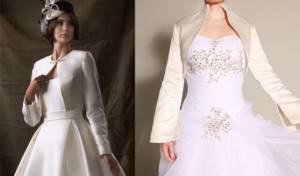
- narrow wrist-length sleeves with lace frills along the perimeter of the cuffs (near the shoulders in some countries a puff sleeve was used);
- the transition from the skirt to the waist is emphasized by a V-shaped line;
- a grangola collar of a lush, rounded shape, maximally covering the girl’s neck (it can be combined with a high, wide collar);
- hats with a net for hair (some styles used a ribbon that covered the chin);
- in addition to the old decorative elements, lush feathers and soft swan down are introduced.
Only royalty could afford to wear slightly open dresses. However, even their décolleté area could easily be hidden by a veil or cape. The 17th century - the century of new views on the world - opened up the opportunity for fashionistas to bare their arms a little.
The length was ¾, with lace cuffs. The V-shaped waistline is rounded. A puffy round collar exists alongside a new high turn-down option.
In France, Italy and the Netherlands, girls are allowed to partially or completely bare their heads.
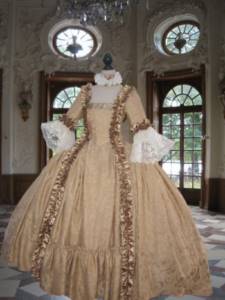
Ornate, intricately braided hairstyles are coming into fashion. Hair is often decorated with fresh flowers, feathers, ribbons, and jewelry. New decorative elements are also added, such as chains and bows.
Wedding dresses of the 17th century have a special flavor. Bright colors of gold, ivory, and often pink, blue, and even variegated versions are in fashion. A veil or veil remains a mandatory element. Its fastening depends on the bride's headdress.
The cut of the skirt also changes. The pomp is created by a special petticoat or frame. Depending on its shape, the dress can change style. Cascading dresses, in which the outer material falls in waves, become interesting. A paper or fabric fan becomes an integral part of every bride's look. Dresses of the 17th century are the standard of chic and luxury. They are voluminous, majestic and very expensive. The cost of a wedding dress could reach incredible proportions.
Some outfits cost as much as an estate with land, peasants and servants in addition.
The real boom in wedding fashion occurred in the 50s of the 20th century.
when outfits with full skirts and necklines, complemented by a veil and short gloves, became popular.
Models that revealed shoulders and strapless dresses appeared, however, there were few brave brides who chose this style. Another 10 years later, short wedding dresses made of cotton, silk and taffeta became popular, and fashionistas replaced the traditional veil with a small hat with a veil or simply decorated their hair with flowers. Many brides chose wedding dresses with short sleeves complete with an airy veil. Designers of that time began to offer newlyweds styles decorated with ribbons, beautiful floral embroidery, lace, as well as luxurious models embroidered with pearls and beads. Bright lipstick has lost its relevance, replaced by matte pale colors and expressive eye makeup. In 1970, the traditional veil lost some of its popularity, but wide-brimmed hats came into fashion, which complemented wedding dresses made from flowing fabrics and, which became popular again, lace fabrics.
Wedding fashion of the 1980s was characterized by luxury and elegance. Brides are again choosing lush dresses, complemented by a long veil and tiara. The image of a beautiful bride of that period was perfectly presented by Princess Diana. The 1990s were characterized by dresses with tight-fitting silhouettes, ball gowns, complemented by a small wedding bouquet, and minimal makeup. In the next decade, brides continue to embrace slim and straight silhouettes, moving away from the classic veil. This accessory is replaced by flower crowns and tiaras. Stylish models with open shoulders are becoming the most popular. Shiny materials (for example, satin or silk) are coming into fashion, but lace is again, undeservedly forgotten.
Wedding bouquet of the bride in the style of the 19th century
A wedding bouquet in the style of the 19th century is elegant and small, mainly made of roses, round in shape. You can use both bright flowers and delicate roses in pastel colors, it all depends on the decor of the hall, the preferences and costume of the bride.
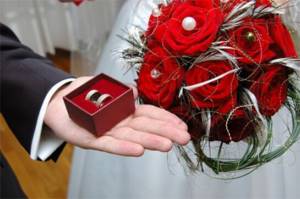
bright classic bouquet
If you like the original bride's bouquet in the form of a classic fan in the photo, you can do something similar.
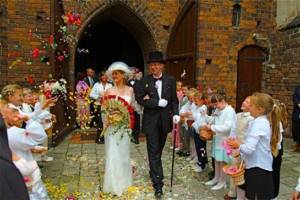
original bridal bouquet
The most magnificent dress
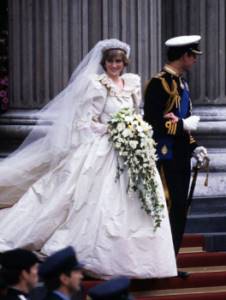
The wedding dress of the British Princess Diana turned the heads of millions of girls around the world, and under its influence, the fashion for lush wedding dresses with a huge amount of decor continued for at least a couple of decades. What can I say, many brides still dream of just such a princess dress, with lace, embroidery, frills, a full skirt, and a long, long train. Diana's dress was made of silk taffeta, the length of its train was almost eight (!) meters, and vintage handmade lace and pearls were used in the decor.
Perhaps such a dress looked appropriate at a royal wedding and against the backdrop of rich interiors. But today, wedding stylists and designers clearly do not approve of the “all at once” approach. The modern bride is advised to choose one accent so as not to look like a “meringue” - this is the word critics called Diana’s dress.
Wedding date : July 29, 1981.
Designers : David and Elizabeth Emanuel.
Cost : Sold at auction for $175 million.
Decor
Weddings in the style of the 18th-19th centuries are characterized by estates or palaces with an abundance of gilded objects in the interior. The presence of gardens, fountains and ponds will completely convey the desired atmosphere, and sunny weather will make the holiday even more ideal.
Modern weddings in the style of previous centuries are gaining popularity and designers are creating the most daring solutions, but they often forget that those centuries were characterized by wearing wigs, which, due to their low popularity, can add great zest to the ceremony.
Classical music will create the atmosphere of the ball, immersing the heroes of the occasion and guests into the wonderful world of past centuries, charging them with the energy of luxury, antiquity and romance.
Venue and decor of a 19th century wedding hall
Special mention should be made about the venue for the wedding ceremony in the style of the 19th century. The ideal option would be to rent a noble mansion, if possible, or a large hall.
Round tables covered with white tablecloths, crystal glasses, luxurious gilded crystal chandeliers, small bouquets of roses on the tables and candelabra will take you back to the 19th century.
Candlelight, high windows, classic furniture, stucco moldings, columns give the room a very special atmosphere.
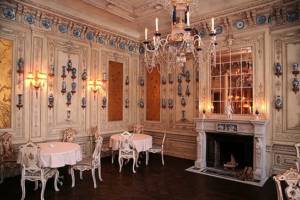
classic 19th century hall
In a large room you can organize a gala ball, but for this you need to be able to dance at least a waltz.
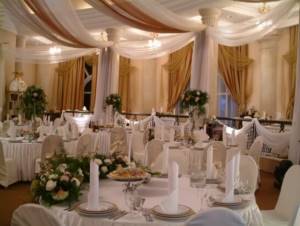
example of hall design
Cakes and ice cream were already popular in the 19th century; confectioners knew how to create real masterpieces in several tiers. It will be good if the cake decor contains classic elements, for example, columns, as in the photo.
Ice cream can also be placed in multi-tiered dishes and decorated accordingly. If you wish, you can please your guests with the aristocratic cuisine of that time - caviar, sterlet dishes, game.
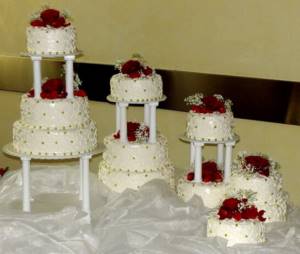
19th century style wedding cake

